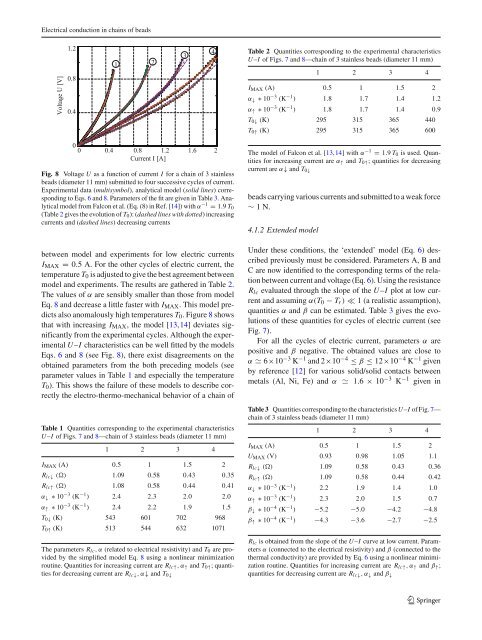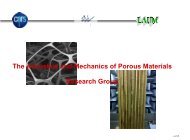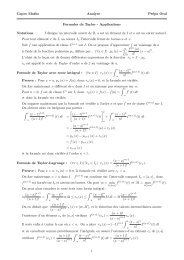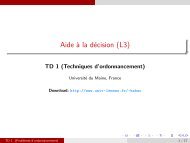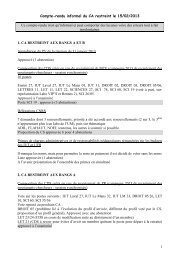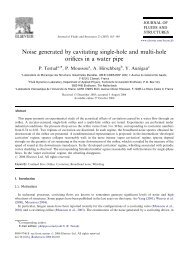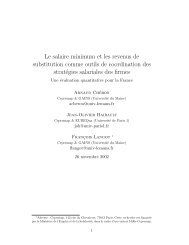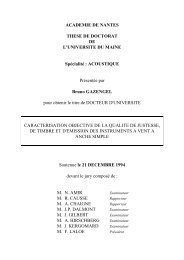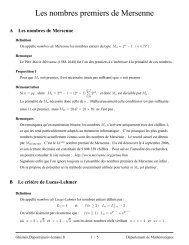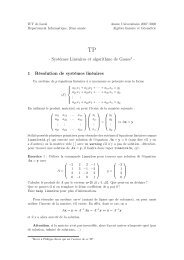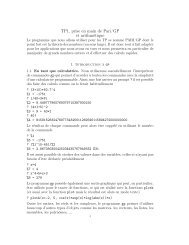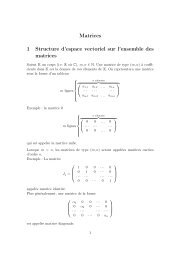P. Béqu<strong>in</strong>, V. Tournat<strong>of</strong> exist<strong>in</strong>g data on the dependence <strong>of</strong> electrical resistivity<strong>and</strong> thermal conductivity on temperature for sta<strong>in</strong>less steels[22,25,26], <strong>and</strong> <strong>in</strong> particular for AISI 440C (code used bythe American Iron <strong>and</strong> Steel Institute) or 1.4125 (Europeanmaterial number).For small electric currents, the voltage V lc (between surfacesS 1 <strong>and</strong> S 2 )<strong>and</strong>thecurrentI are observed to be l<strong>in</strong>earlydependent such as V lc = R lc I ,whereR lc is determ<strong>in</strong>ed bythe slope <strong>of</strong> the U–I plot at low current (Fig. 2).The substitution <strong>of</strong> the first two terms <strong>of</strong> the Taylor expansion<strong>of</strong> ρλ ≃ ρ r λ r {1 + (α + β)(T − T r )} <strong>in</strong>to Eqs. 3 <strong>and</strong> 4,leads to the potential difference between electrodes given byHolm [7]:V lc (T 0 ) = R lc I = ρ 0 2(n + 1) √ ρ r λ rρ r (α + β) 3 2{ []W(T 0 )× α arctan1 + (α + β)(T 0 − T r )}+ β W(T 0 )√where W(T 0 ) = α+β U(T0 )2(n+1) √ <strong>and</strong> ρρ r λ 0 = ρ r {1 + α(T 0 − T r )}.rBy <strong>in</strong>troduc<strong>in</strong>g the maximum values <strong>of</strong> the electric currentI MAX <strong>and</strong> <strong>of</strong> the voltage U MAX ,Eq.6 can be rewritten as[]W(Tα arctan0 )1+(α+β)(T 0 −T r )+ β W(T 0 )I = I MAX [] , (7)α arctan+ β W MAXW MAX1+(α+β)(T 0 −T r )√ α+β UMAX2(n+1) √ ρ r λ r.where W MAX =Equations 6 <strong>and</strong> 7 give the relation between the current I<strong>and</strong> the potential difference U between n beads, with α <strong>and</strong> βtwo parameters to be adjusted. For weak currents I <strong>in</strong> Eq. 6,the l<strong>in</strong>ear dependence between current <strong>and</strong> voltage is foundby impos<strong>in</strong>g |β| ≪ α. Forhighercurrents,thefollow<strong>in</strong>gsimplifications can be used:– the temperature T r associated to the reference variablesis equal to the temperature <strong>of</strong> the beads T 0 when theycarry a weak current I ;– the material at the contact follows the Wiedemann–Franz’s law which states that the product <strong>of</strong> the thermalconductivity by the electrical resistivity <strong>of</strong> a metalis proportional to the temperature: ρ r λ r = LT 0 ,whereL = 2.45 × 10 −8 V 2 /K 2 is the Lorenz number;– consequence <strong>of</strong> the preced<strong>in</strong>g assumption, the quantityα + β must be close to 1/T 0 .Under these assumptions, the relation between the current I<strong>and</strong> the voltage U can be written <strong>in</strong> the simplified form [7,8]:I = V lc(T 0 )= 2(n + 1)T √0 LR lc R lc× {αT 0 arctan [U(T 0 )] + (1 − αT 0 ) U(T 0 )} . (8)(6)where U(T 0 ) = U(T 0)2(n+1)T 0√L.4.1 DiscussionTo identify the limitations <strong>of</strong> the previous models (Eqs. 6 <strong>and</strong>8), experimental data (U, I ) obta<strong>in</strong>ed <strong>in</strong> a cha<strong>in</strong> <strong>of</strong>three beads (diameter 11 mm) carry<strong>in</strong>g a current with cycles<strong>of</strong> <strong>in</strong>creas<strong>in</strong>g <strong>and</strong> decreas<strong>in</strong>g values, are now presented.Figure 7 shows how voltage U <strong>and</strong> power P vary withcurrent I .From the preced<strong>in</strong>g paragraph it can be seen that both Eqs.6 <strong>and</strong> 8, provid<strong>in</strong>garelationbetweenthecurrentI <strong>and</strong> thevoltage U,presentasimilarform:I = A arctan(BU)+CU.Parameters A, B <strong>and</strong> C can be adjusted to obta<strong>in</strong> the best fitwith the experimental data, as shown <strong>in</strong> Figs. 6 <strong>and</strong> 8.4.1.1 Simplified modelsBy identify<strong>in</strong>g parameters A, B <strong>and</strong> C to the correspond<strong>in</strong>gterms <strong>of</strong> the simplified relation between current <strong>and</strong> voltage(Eq. 8), R lc , α <strong>and</strong> T 0 can be determ<strong>in</strong>ed. Table 1 givesthe evolution <strong>of</strong> the latter quantities for successive cycles <strong>of</strong>electric current. Values <strong>of</strong> R lc are identical to those determ<strong>in</strong>edby the slope <strong>of</strong> the U–I plot at low current (see values<strong>of</strong> R lc listed <strong>in</strong> Table 3). The values <strong>of</strong> α are positive <strong>and</strong>decrease slowly with the current I MAX . This <strong>effect</strong> is discussedlater <strong>in</strong> this article. The values (α ≃ 2 × 10 −3 [K −1 ])are close to the values (α ≃ 6 × 10 −3 [K −1 ])given<strong>in</strong>Ref.[12]forvarioussolid/solidcontactsbetweenmetals(Al,Ni,Fe) <strong>and</strong> (α ≃ 1.6 × 10 −3 [K −1 ])given<strong>in</strong>Ref.[22] forasta<strong>in</strong>less steel AISI 420. F<strong>in</strong>ally, an important feature <strong>of</strong> thesimplified model is the prediction <strong>of</strong> temperatures T 0 <strong>of</strong> thebulk <strong>of</strong> the beads with anomalously high values comparedto the expected values around 300 K. This discrepancy maybe attributed to the use <strong>of</strong> Wiedemann–Franz’s law whichhas been found to be <strong>in</strong>adequate for some materials (iron <strong>and</strong>nickel for <strong>in</strong>stance [8]).However, it is <strong>in</strong>terest<strong>in</strong>g to note that an equivalent form<strong>of</strong> this simplified model is used by Falcon et al. [13,14](Eq.(8) <strong>in</strong> Ref. [14]) <strong>and</strong> it correctly models the electro-thermalphenomena <strong>in</strong> the cha<strong>in</strong> <strong>of</strong> sta<strong>in</strong>less steel beads (martensiticsta<strong>in</strong>less steel AISI 420). In this model [13,14], the coefficientα is <strong>in</strong>itially deduced from the relation α −1 = 3.46 T 0(for an austenitic sta<strong>in</strong>less steel AISI 304—see Ref. [26] from[14]) <strong>and</strong> is then replaced by the relation α −1 = 4 T 0 <strong>in</strong> orderto obta<strong>in</strong> a better agreement between predictions <strong>and</strong> experimentaldata for martensitic sta<strong>in</strong>less steel beads AISI 420used <strong>in</strong> the experimental system.Figure 8 compares the experimental data (obta<strong>in</strong>ed <strong>in</strong> ourcha<strong>in</strong> <strong>of</strong> 3 martensitic sta<strong>in</strong>less steel beads AISI 440C) <strong>and</strong>the model [13,14] with α −1 = 1.9 T 0 .Thislastexpressionwith factor 1.9 isfoundtoprovidethebestagreement123
<strong>Electrical</strong> <strong>conduction</strong> <strong>in</strong> cha<strong>in</strong>s <strong>of</strong> beadsTable 2 Quantities correspond<strong>in</strong>g to the experimental characteristicsU–I <strong>of</strong> Figs. 7 <strong>and</strong> 8—cha<strong>in</strong> <strong>of</strong> 3 sta<strong>in</strong>less beads (diameter 11 mm)1 2 3 4I MAX (A) 0.5 1 1.5 2α ↓ ∗ 10 −3 (K −1 ) 1.8 1.7 1.4 1.2α ↑ ∗ 10 −3 (K −1 ) 1.8 1.7 1.4 0.9T 0↓ (K) 295 315 365 440T 0↑ (K) 295 315 365 600Fig. 8 Voltage U as a function <strong>of</strong> current I for a cha<strong>in</strong> <strong>of</strong> 3 sta<strong>in</strong>lessbeads (diameter 11 mm) submitted to four successive cycles <strong>of</strong> current.Experimental data (multisymbol), analytical model (solid l<strong>in</strong>es) correspond<strong>in</strong>gto Eqs. 6 <strong>and</strong> 8. Parameters <strong>of</strong> the fit are given <strong>in</strong> Table 3.Analyticalmodel from Falcon et al. (Eq. (8) <strong>in</strong> Ref. [14]) with α −1 = 1.9 T 0(Table 2 gives the evolution <strong>of</strong> T 0 ): (dashed l<strong>in</strong>es with dotted) <strong>in</strong>creas<strong>in</strong>gcurrents <strong>and</strong> (dashed l<strong>in</strong>es) decreas<strong>in</strong>g currentsbetween model <strong>and</strong> experiments for low electric currentsI MAX = 0.5 A.Fortheothercycles<strong>of</strong>electriccurrent,thetemperature T 0 is adjusted to give the best agreement betweenmodel <strong>and</strong> experiments. The results are gathered <strong>in</strong> Table 2.The values <strong>of</strong> α are sensibly smaller than those from modelEq. 8 <strong>and</strong> decrease a little faster with I MAX .Thismodelpredictsalso anomalously high temperatures T 0 .Figure8 showsthat with <strong>in</strong>creas<strong>in</strong>g I MAX ,themodel[13,14] deviatessignificantlyfrom the experimental cycles. Although the experimentalU–I characteristics can be well fitted by the modelsEqs. 6 <strong>and</strong> 8 (see Fig. 8), there exist disagreements on theobta<strong>in</strong>ed parameters from the both preced<strong>in</strong>g models (seeparameter values <strong>in</strong> Table 1 <strong>and</strong> especially the temperatureT 0 ). This shows the failure <strong>of</strong> these models to describe correctlythe electro-thermo-mechanical behavior <strong>of</strong> a cha<strong>in</strong> <strong>of</strong>Table 1 Quantities correspond<strong>in</strong>g to the experimental characteristicsU–I <strong>of</strong> Figs. 7 <strong>and</strong> 8—cha<strong>in</strong> <strong>of</strong> 3 sta<strong>in</strong>less beads (diameter 11 mm)1 2 3 4I MAX (A) 0.5 1 1.5 2R lc↓ () 1.09 0.58 0.43 0.35R lc↑ () 1.08 0.58 0.44 0.41α ↓ ∗ 10 −3 (K −1 ) 2.4 2.3 2.0 2.0α ↑ ∗ 10 −3 (K −1 ) 2.4 2.2 1.9 1.5T 0↓ (K) 543 601 702 968T 0↑ (K) 513 544 632 1071The parameters R lc , α (related to electrical resistivity) <strong>and</strong> T 0 are providedby the simplified model Eq. 8 us<strong>in</strong>g a nonl<strong>in</strong>ear m<strong>in</strong>imizationrout<strong>in</strong>e. Quantities for <strong>in</strong>creas<strong>in</strong>g current are R lc↑ , α ↑ <strong>and</strong> T 0↑ ; quantitiesfor decreas<strong>in</strong>g current are R lc↓ , α↓ <strong>and</strong> T 0↓The model <strong>of</strong> Falcon et al. [13,14] withα −1 = 1.9 T 0 is used. Quantitiesfor <strong>in</strong>creas<strong>in</strong>g current are α ↑ <strong>and</strong> T 0↑ ; quantities for decreas<strong>in</strong>gcurrent are α↓ <strong>and</strong> T 0↓beads carry<strong>in</strong>g various currents <strong>and</strong> submitted to a weak force∼ 1N.4.1.2 Extended modelUnder these conditions, the ‘extended’ model (Eq. 6) describedpreviously must be considered. Parameters A, B <strong>and</strong>Carenowidentifiedtothecorrespond<strong>in</strong>gterms<strong>of</strong>therelationbetween current <strong>and</strong> voltage (Eq. 6). Us<strong>in</strong>g the resistanceR lc evaluated through the slope <strong>of</strong> the U–I plot at low current<strong>and</strong> assum<strong>in</strong>g α(T 0 − T r ) ≪ 1 (a realistic assumption),quantities α <strong>and</strong> β can be estimated. Table 3 gives the evolutions<strong>of</strong> these quantities for cycles <strong>of</strong> electric current (seeFig. 7).For all the cycles <strong>of</strong> electric current, parameters α arepositive <strong>and</strong> β negative. The obta<strong>in</strong>ed values are close toα ≃ 6×10 −3 K −1 <strong>and</strong> 2×10 −4 ≤ β ≤ 12×10 −4 K −1 givenby reference [12] forvarioussolid/solidcontactsbetweenmetals (Al, Ni, Fe) <strong>and</strong> α ≃ 1.6 × 10 −3 K −1 given <strong>in</strong>Table 3 Quantities correspond<strong>in</strong>g to the characteristics U–I <strong>of</strong> Fig. 7—cha<strong>in</strong> <strong>of</strong> 3 sta<strong>in</strong>less beads (diameter 11 mm)1 2 3 4I MAX (A) 0.5 1 1.5 2U MAX (V) 0.93 0.98 1.05 1.1R lc↓ () 1.09 0.58 0.43 0.36R lc↑ () 1.09 0.58 0.44 0.42α ↓ ∗ 10 −3 (K −1 ) 2.2 1.9 1.4 1.0α ↑ ∗ 10 −3 (K −1 ) 2.3 2.0 1.5 0.7β ↓ ∗ 10 −4 (K −1 ) −5.2 −5.0 −4.2 −4.8β ↑ ∗ 10 −4 (K −1 ) −4.3 −3.6 −2.7 −2.5R lc is obta<strong>in</strong>ed from the slope <strong>of</strong> the U–I curve at low current. Parametersα (connected to the electrical resistivity) <strong>and</strong> β (connected to thethermal conductivity) are provided by Eq. 6 us<strong>in</strong>g a nonl<strong>in</strong>ear m<strong>in</strong>imizationrout<strong>in</strong>e. Quantities for <strong>in</strong>creas<strong>in</strong>g current are R lc↑ , α ↑ <strong>and</strong> β ↑ ;quantities for decreas<strong>in</strong>g current are R lc↓ , α ↓ <strong>and</strong> β ↓123


